Opinion
It’s the best part of the Gold Coast, but most drive straight past
Craig Tansley
Travel writerA house across the road from me sold for $12.5 million yesterday. It doesn’t look anything special, though it is on the beach. The buyer is from Bondi … of course.
What surprises me is that I’m not surprised. My suburb – Palm Beach (not that Palm Beach) – is one of the most-searched suburbs in Australia on realestate.com.au. Since COVID, the average price of a home here has increased by over 50 per cent.
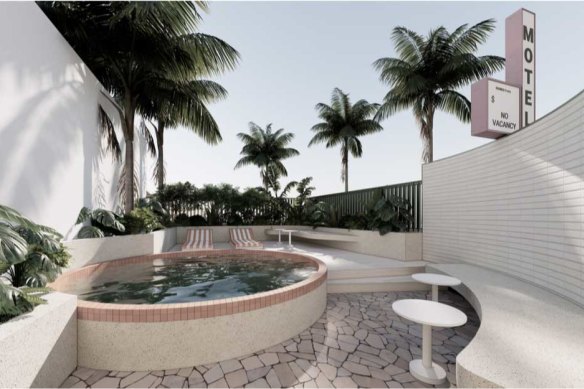
Cheshire Cat Motel joins a growing number of retro-style seaside motels.
And yet, if you’re not planning to move here from Sydney or Melbourne, this southern part of the Gold Coast is still a mystery to most of you. Ahead of the Easter holidays this year, the Gold Coast was named the top destination Australians were looking to travel to within Australia on booking.com. But far fewer of you came to this Gold Coast. You stayed in high-rise hotels on the other Gold Coast – the northern part where us southerners never go.
If you flew to Coolangatta (Gold Coast Airport), you drove right past us. We don’t have big chain hotels like they do in Surfers Paradise and Broadbeach; you have to dig deeper to find a place to stay (though we have everything from palatial estates on the beach – like Rolling Seas – to Australia’s best collection of refurbished retro-style seaside motels).
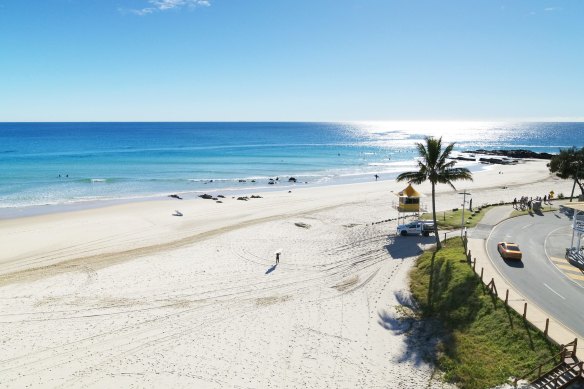
Home to some of the best surf beaches on Earth, all protected in a reserve.Credit: Destination Gold Coast
The Gold Coast isn’t officially divided into two, it’s just that every local thinks it is. Burleigh Heads is where the Gold Coast splits down the middle. The northern Gold Coast has housed the lion’s share of NSW and Victorian visitors since Surfers Paradise built its first high-rise in 1960. The definitive Gold Coast holiday revolved around skyscrapers with swim-up bars, Sea World (which opened in 1971), Dreamworld (1981) and Reg Grundy’s World, where families could ride waterslides into the main street of Surfers Paradise.
The southern Gold Coast remained an outpost – popular only to surfers and families from next door at the Tweed, and Brisbane. Though it was fringed by a mountainous green hinterland, part of a 20-million-year-old volcanic caldera, and the entire 16-kilometre stretch of beaches is a World Surfing Reserve, it was as basic as a country town.
I moved here in 2017, and that was meant to be temporary. I grew up just south (in the Byron Shire): the Gold Coast was somewhere we came out of necessity, then got out again fast. But the #’17 model looked a different beast. And it was changing by the week.
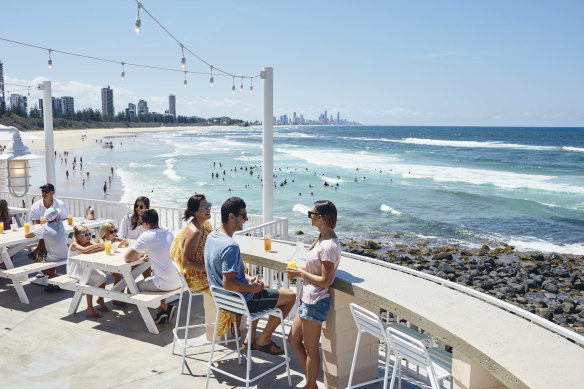
Burleigh Pavilion is part of the gentrification of the south.Credit: Tourism and Events Queensland
There were trail-blazers, like UK-born Jeremy Davidson, who established The Collective at Palm Beach at Christmas 2016. He rebuilt the old post office into a trendy communal space with five kitchens on the same menu, modelled on the markets of Madrid. And Brisbane-born Nick Woodward and his schoolmates who opened a pan-Asian gourmet restaurant with a colonial twist on the beach at Burleigh (Rick Shores). It soon became Queensland’s number-one ranked restaurant.
When NZ-born couple, Isla and John Wilson, opened a cafe (Dust Temple) that was also an art gallery and live music space out of a T-shirt factory in Currumbin’s industrial estate, locals – especially us transplants – celebrated like we built it ourselves. Each opening was its own cultural revolution.
“For so long it’s been about surf culture here,” John Wilson said.
“But we want to help make this area a destination for art and culture.”
A group of local surfers, including world champions Mick Fanning and Joel Parkinson, opened a craft beer brewery with a bar (Balter) 300 metres down the road which soon produced Australia’s top-rating beer. A new whiskey bar (Scottish Prince) hidden behind red curtains in Palm Beach finally gave us a drinking option that wasn’t a surf club (it closed this year). In 2018, Restaurant Labart – a Parisian-style bistro which relied solely on its food, not water views – opened in Burleigh. It was created by Sydney chef (former head chef of Monopole and Marque) Alex Munoz who soon declared the Gold Coast had more fine dining options than Byron Bay and Noosa combined.
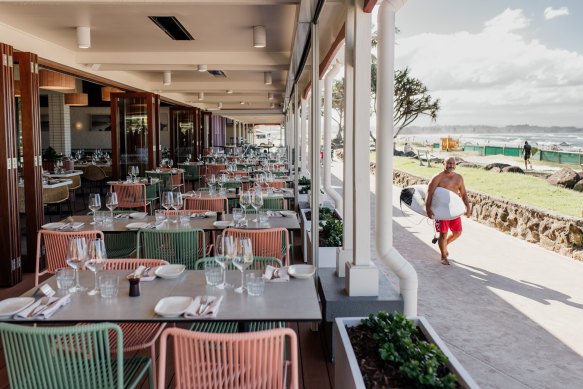
Surfers are never far away from anywhere you’ll dine on the southern Gold Coast.Credit: Siblings Kirra
The south was gentrifying fast – we could barely keep up with the openings – yet seven minutes’ drive west, there were still farmers selling horse poo for $5 at honesty stalls by the side of country roads, and our beaches were mostly empty, even on weekends.
House prices were low, rent was cheap, culture was coming thick and fast into a community keen to corral it. Life began to feel like the Byron Bay of my childhood (the 1980s) when it began its slow metamorphosis from humble blue-collar town to global coastal cultural HQ. But no one outside of here knew; even Byron folk barely 40 minutes’ drive south still thought we were a bunch of bogans.
Hospitality entrepreneur Dave Galvin moved to the southern Gold Coast from the north (he’d left Sydney to open QT Gold Coast and never moved back).
“There were beautiful little micro-environments happening down this side of the coast,” he says.
“It’s a hidden secret … still. I own a restaurant in Broadbeach, when I talk about the southern Gold Coast with people there they all say, ‘yeah, I have to get down that way soon’. ”

Kirra Beach House is proof the southern Gold Coast is changing.
Then COVID hit, and Melbourne and Sydney began buying up the southern Gold Coast, sight-unseen. Over 50,000 (across the whole Gold Coast) of you moved; celebrities like Buddy Franklin and Jesinta Campbell bought apartments in southern Gold Coast suburbs no one had heard of, like Bilinga.
Hospitality entrepreneurs arrived, and culinary (and hospitality) talent of a level we’d never experienced. We were becoming a little bit Melbourne, with better beaches.
Galvin opened an ambitious 1200-square-metre beach house near the NSW border at Kirra (Kirra Beach House) with capacity for 750 people, with wine and cocktail bars and lounge areas with cabanas and DJs and an enormous terrace looking across the ocean. It wouldn’t have worked in the previous era.
“I sensed it [gentrification] was starting to happen, I just never imagined it was going to be expedited so quickly through something like COVID,” he says.
“Before COVID, it used to be when we hired anyone, if they were good, not great, I was going to lose them to Brisbane. If they were great, I’d lose them to Sydney or Melbourne. Now we’re getting really talented people coming here to stay, and at a really senior level. But this southern part stays under the radar because there’s no big hotels to stay at.”
So where are we at in 2024? The influx of new arrivals has stemmed the flow of the Gold Coast Highway – the main thoroughfare through the southern Gold Coast. And forget about parking in Burleigh Heads – take an Uber. And book at least three weeks ahead at Rick Shores, and Restaurant Labart (these aren’t tourists taking the tables, they’re new locals).
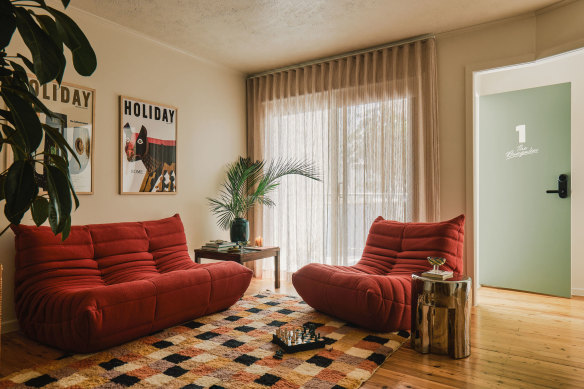
Palm Beach local Matty Roberts moved back to open retro-style motel, Cheshire Cat.
But I have a French bakery next door to me whose owners actually come from France, and an Italian cafe round the corner whose staff all come from Italy (via Melbourne) – this in a region where diversity even just five years ago meant not having blonde hair. And there’s a bona fide nightlife here now: restaurants stay open after 8.30pm. Many long-term locals bemoan the transformation, but gentrification is always a double-edged sword.
Matty Roberts grew up in Palm Beach (the suburb had a shady reputation until the mid-2010s), then moved back during COVID to open a retro-style motel, The Cheshire Cat.
“I’m not sure I could’ve lived here before,” he says.
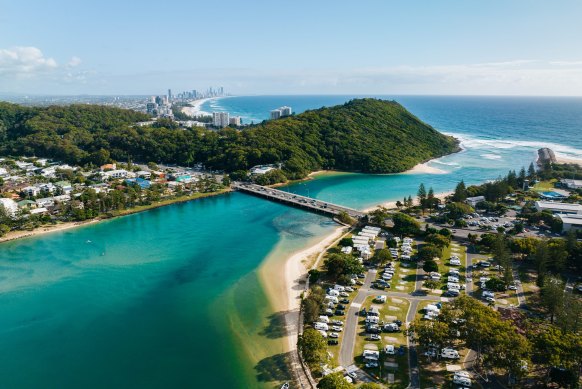
Tallebudgera Creek is near where the Gold Coast splits into two distinct sides.Credit: Tourism and Events Queensland
“Most of us who moved away now have more to go back to. With everyone moving up from down south they’re opening bars, and restaurants and cafes. But I like that everything’s still understated, and sea-based, even semi-rural. We have the sensibilities of the Byron Shire, and everyone still wears thongs.”
While Roberts says the southern Gold Coast now reminds him … “a little” … of Sydney’s eastern suburbs, we’re nowhere near there … yet (though Burleigh Heads will get its first big ‘chain’ hotel, Mondrian, later this year, offering 209 rooms). Our beaches are mostly still deserted – except the sheltered ones families prefer around our two waterways, Currumbin and Tallebudgera Creeks. They’re still selling horse poo on the drive out to Currumbin Valley, but it’s $10 now. The southern Gold Coast is gentrifying fast, but unless you packed up and moved here, most of you still don’t even know we exist. And we don’t mind a bit.
The details
More
Fly
Qantas, Virgin Australia and Jetstar fly several times daily to the Gold Coast from Sydney and Melbourne. See qantas.com/au; virginaustralia.com/au; jetstar.com/au
Stay
Stay in a three-bedroom villa five minutes from the airport beside the region’s most underrated beach from $500 per night. See bilingabeachabodes.com.au
Stay in a recently restored 1960s motel beside the beach at Palm Beach from $270 a night. See cheshirecatmotel.com
Eat + drink
Choose between a wine and cocktail bar and eat overlooking Kirra’s World Heritage listed waves. See kirrabeachhouse.com
Have a coffee at the cafe that started the revolution. See dusttemple.com.au
Book ahead at the region’s best restaurants: Rick Shores. See rickshores.com.au
Restaurant Labart. See restaurantlabart.com
Enjoy views across the ocean to Surfers Paradise. See siblingskirra.com.au
Relax beside Currumbin Creek at Tarte Beach House. See tarte.com.au
The writer travelled courtesy of Destination Gold Coast
Sign up for the Traveller Deals newsletter
Get exclusive travel deals delivered straight to your inbox. Sign up now.